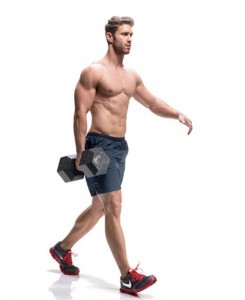Too Much of a Good Thing
There are certain things in life that are good for us. For example, as the winter approaches we know the importance of vitamin D and getting exposure to sunlight. Unfortunately, flying to a beach vacation and spending the whole day in the sun may result in sun stroke and sun burn.
Another example is drinking water, especially during prolonged, strenuous exercise. Some people are so on top of staying hydrated that they can dilute the salt concentration of their cells to such an extend they hinder performance.
Basically the take home message is that too much of good thing can render that good thing, bad. Such is the case with a couple of exercises commonly performed in training programs.
The first is the suitcase carry.
[caption id="attachment_4985" align="aligncenter" width="245"] If luggage didn't have wheels this is what we'd be doing in airports.
This exercise is great because it helps develop grip strength and it allows you to train each side independently. Targeted muscles include the lats, the quadratus lumborum and medial glutes. To perform effectively you want to select a heavy enough load to reap all the benefits.
In terms of your technique we want to walk as straight of a line as possible. Follow the seam on the floor in your gym or imagine walking a tight-rope. The straighter the line you walk, the better.
Secondly, you want to walk tall. Look off in the horizon with chest tall and head neutral. Imagine the military 'at attention' look and you've got it.
Lastly, and this part is most often messed up, don't collapse sideways under the load in one hand. Both shoulders and hips should be level throughout and the hand shouldn't be collapsed into the side of the body. You don't have to be doing a lateral raise while walking but the weight should not on the body while walking.
The next exercise that has become popular over the last few years but overloaded is the barbell hip thrust. Simply because a weight moves from A to B doesn't mean the lift was performed correctly.
Here's what the barbell hip thrust looks like:
[caption id="attachment_4987" align="aligncenter" width="300"] Don't overload or you risk compensating or shortening the range of motion.
Don't overload or you risk compensating or shortening the range of motion.
Recently there has been more and more discussion regarding overloading this movement. If someone used too much load on a deadlift it would be obvious based on rounding through the back or over-arching to complete a rep. And it's also very clear when a deadlift rep is not completed or 'locked out' at completion.
Sometimes with heavy barbell hip thrusts you can see the following problems arise including:- excessive head motion to serve as a driver for the hips
- over-arching the lumbar to make up for incomplete hip extension
- failing to achieve complete hip range of motion
https://www.youtube.com/watch?v=WL555imxB5M
Going forward remember to take some time to get comfortable and familiar with the farmer's carry and barbell hip thrust. And once you feel your technique is good resist the temptation to go too heavy on performing these. The potential to compensate or injure yourself is too great.
When you subscribe to the blog, we will send you an e-mail when there are new updates on the site so you wouldn't miss them.

Comments